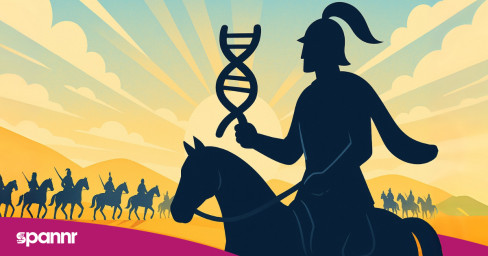Your DNA Gets Vandalized 19,000 Times Daily (Here's How to Fight Back)

The 12 Horsemen of Aging: When Your DNA's Guardian Falls Asleep on the Job
First in a series exploring the cellular chaos that makes us age—and what we can do about it
What's This Whole Horsemen Thing About?
I’m certain we all know about the Four Horsemen of the Apocalypse from the Bible—those scary guys who bring war, famine, pestilence, and death. Well, science has discovered our bodies have their own apocalypse squad: 12 Horsemen of Aging that slowly but surely wreak havoc on our cells. You might have heard these referred to as the ‘12 Hallmarks of Aging’ and I want to give these a tweak to be a bit more memorable. The 12 Hallmarks are each their own category that needs addressing on their own, so we can address the whole issue that is aging.
So with that said, today we're meeting the first rider: Genomic Instability—aka "The DNA Destroyer." This is the cellular equivalent of having a really bad security guard who keeps letting vandals into your house while he's scrolling through his social media feed.
And FYI - Genomic instability is when the instruction book inside your cells (AKA, DNA) gets damaged over time.
Think of your DNA like a recipe book that tells your body how to work - genomic instability happens when pages get torn or words get smudged, making it harder for your body to follow the recipes correctly as you get older.
Your DNA: The Ultimate Fixer-Upper Project Gone Wrong
Picture this: You're living in a house that gets hit by about 800 mini-disasters every single hour[2]. Pipes leak, walls have little cracks, windows get hard to shut. That's basically what's happening to your DNA right now as you read this. We're talking 19,000 hits to your genetic code every day]—more damage than what my 4 year old with a crayon and unlimited wall access could do.
And, here's the amazing part: your body has an incredible repair crew working around the clock. These molecular handymen cruise around fixing DNA damage before it becomes a real problem. So what's the issue? As we age, these handymen start showing up to work hungover, calling in sick, and generally doing a pretty terrible job.
When DNA Repair Goes Horribly Wrong: Real Horror Stories
I wasn't sure if I was going to include this when I was first writing this outline, and I think it's good to share because it illustrates a very important point. Want to see what happens when your DNA repair system completely fails? Meet the people with xeroderma pigmentosum (try saying that three times fast). These folks have a genetic condition where their DNA repair is basically non-existent.
The result? They can't go outside without looking like they've been deep-fried. Even a few minutes of sunlight causes severe burns and skin cancer. One little girl with this condition has to live her entire life avoiding any UV light—she's literally allergic to sunshine because her cells can't fix the DNA damage it causes.
It's heartbreaking, but it shows us exactly how crucial DNA repair is. Without it, we'd all be toast—literally.
The Science Behind Your Cellular Chaos
Every day, your DNA gets hammered by:
> Oxidative stress from normal metabolism (like cellular exhaust fumes)
> Environmental toxins from pollution, chemicals, and radiation (in your food, especially if you are in the US and environment)
> Natural cellular processes that just wear things down over time
The main culprit? Those sneaky little molecules called reactive oxygen species (ROS)—basically your cells' equivalent of rust. They go around oxidizing everything, including your precious DNA, turning it into cellular garbage.
Your DNA Repair Toolbox: Meet the Crew
Your body has several DNA repair systems working like different contractor crews:
> Base Excision Repair (BER): The detail crew that fixes small dings and scratches
> Nucleotide Excision Repair (NER): The heavy-duty team that removes big chunks of damaged DNA
> Homologous Recombination: The specialists who fix the really nasty double-strand breaks
When these crews start slacking off with age, mutations pile up like dirty dishes in your kitchen. Eventually, cells either self-destruct (which isn't great for your tissues) or turn senescent—basically becoming the cellular equivalent of that grumpy neighbor who yells at kids and makes everyone else miserable. (Read about how to deal with these here)
Your Anti-Aging Arsenal: Foods That Fight DNA Damage
Ready for the good news? You can actually help your DNA repair crew do their job better. Here's your shopping list of DNA-protective superfoods:
The All-Stars
> Broccoli and cruciferous vegetables: These green warriors contain compounds that literally boost your DNA repair mechanisms. Think of them as energy drinks for your cellular repair crew. I add broccoli sprouts to everything, since they are even higher in sulforaphane and NMN.
> Berries: Blueberries, strawberries, and raspberries are like little antioxidant bombs that can reduce DNA damage by up to 20%.
> Citrus fruits: Lemons can cut DNA damage by about a third—and it's not just the vitamin C doing the work. Add lemon and limes to everything from water to salads.
The Supporting Cast
> Brazil nuts: Just one nut gives you a full day's worth of selenium, a mineral that's crucial for DNA repair.
> Wild-caught salmon: Loaded with omega-3s that protect your DNA from damage. Also don't forget about the sardines!
> Green tea: Contains polyphenols that act like bodyguards for your genetic code.
The Spice Cabinet Heroes
Ginger is a DNA damage-fighting superstar, protecting against 68% of cellular damage in lab studies. Turmeric, cumin, and fennel also pack serious DNA-protective punch.
Your Daily DNA Defense Plan
Here's what you can do starting today:
1. Load up on colorful vegetables: Aim for at least 5 servings daily. The more colors, the better—think of it as a rainbow of DNA protection. Remember you can get multiple servings in one meal.
2. Sip some green tea: 2-3 cups daily gives you optimal DNA-protective benefits. Matcha lattes for the win! (skip the sugar in them though!)
3. Add a Brazil nut to your routine: Just one daily covers your selenium needs.
4. Spice things up: Use turmeric, ginger, and other antioxidant-rich spices liberally.
5. Choose organic when possible: Studies show organic foods may provide better DNA protection.
The Bottom Line
Genomic instability might be the first Horseman of Aging, but it doesn't have to win. Every time you choose that kale salad over the burger, or sip green tea instead of another coffee, you're giving your cellular repair crew the tools they need to keep your DNA in fighting shape. Remember discipline is way cheaper than regret!
Your genes aren't your destiny—your dinner plate is your defense. (Vitamins too!)
Next week, we'll meet the second Horseman: Telomere Attrition—the cellular countdown timer that's slowly chipping away your youth. Spoiler alert: as you've guessed by now, there are ways to slow that clock down.
Want more longevity secrets delivered to your inbox? Subscribe to the SPANNR newsletter and join thousands of other readers who are aging backward, one cell at a time.
-
https://nutritionfacts.org/video/fruits-vegetables-boost-dna-repair/
-
https://www.annualreviews.org/doi/10.1146/annurev-biochem-062917-012239
-
https://www.sciencedaily.com/releases/2006/02/060209185153.htm
-
https://wildwoodhealth.com/cancer-prevention-strategies-dna-repair/
-
https://nutritionfacts.org/blog/how-to-boost-dna-repair-with-produce/
-
https://thehealthsciencesacademy.org/health-tips/superfoods/
-
https://www.sciencedirect.com/science/article/pii/S0308814612005845
About the Author
Sign Up For Our Newsletter
Weekly insights into the future of longevity
